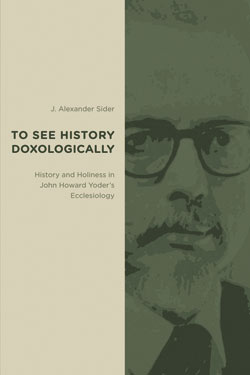If the grim historical associations with words like “purity” and “cleansing” are any indication, then Sider is right to suggest that the church has had trouble reconciling the messiness of life with its concept of holiness. To See History Doxologically is a direct engagement with the tendency to sever holiness from the difficulty of life. Sider frames this question in the context of how we understand and tell our history.
The title of this book is taken directly from John Howard Yoder. Yoder is brought into conversation with a diverse range of thinkers including Oliver O’Donovan, Ernest Troelstch, and Miroslav Volf. In this conversation Sider attempts to tease out how the church is able to hold, with integrity, the fallibility of its past and present with the hope, witness, and work of the reconciling Jesus.
“‘To see history doxologically,’ Yoder said, is to ‘describe the cosmos in terms dictated by the knowledge that a once slaughtered Lamb is now living’” (137). Sider suggests that when we speak of our history and our present, the marks of the slaughter (the difficulty of life) are not erased, but must figure into our accounts and our actions as they lead into our revealed future.
Sider’s criticism with the non-Yoderian accounts is that they tend to collapse either the vision of the resurrection or the reality of our sin. They make the church difficult but not holy, or holy but not difficult. Yoder’s vision is an attempt to hold open the difficult (and as such vulnerable) work of patience that earnestly believes that all can be saved and reconciled. Sider spends the bulk of the book working through this image with his conversation partners.
Sider’s concern with O’Donovan in chapter one is that O’Donovan’s political theology becomes too closely linked to the idea of Jesus having fulfilled the political vision of Israel. The church then exists in this interim period, in which secular authorities are also called on to rule, with the church anticipating but not imitating what was and is to come.
With Troesltch, Sider addresses the role of history in understanding the tension between the contingent expressions and universal claims of the church. By maintaining an absolute “faith” in the value of Christianity, Troesltch ends up sealing off the church from its historical content and renders the church formally true but functionally or practically blank.
In chapter three, Sider questions whether Yoder himself was thoroughgoing enough in his vision. Sider criticizes Yoder’s non-Constantianism as being formed, at least in part, by a Constantinian method of history that assumes too much of history in its ability to be unified to address the present.
When addressing Volf, Sider raises concerns that Volf unhelpfully “purifies” the church by endorsing the need for individuals to temporally forget or “non-remember” past sins until a final reconciliation. While understandable, this non-remembering of injustices becomes pre-emptive of what can be possible when our histories are allowed into the doxological vision of the slain lamb who lives. In all these accounts the difficulty of life, as it is recounted and as it is lived, is deflected from the life of the church, as though God’s call of holiness could not engage such messiness.
This book is a revision of Sider’s PhD dissertation. It is a careful and dense body of work which has an awkward style at times. While it is clear at the beginning and end that Sider wants it to be accessible and relevant for the church, most of it is conceptually demanding and rigorously expressed (often with extended footnotes). This is not a criticism of what Sider wants to accomplish, only a note of caution for the reader.
In the end Sider calls the church to embrace holiness as difficulty. It will always be a temptation to either bemoan compromise (the loss of holiness) or attempt to purify any trace of the messiness of life. To hold open this difficult holiness calls for a particular kind of patience; to “keep your mind in hell and despair not” (202). This phrase, taken from Gillian Rose, reflects both the work and the openness necessary to navigate boundaries and allow them to dissolve and be re-enforced as the twin realities of life and holiness are taken up into the praise of Lamb of God who takes away the sin of the world.








Leave a Reply
You must be logged in to post a comment.